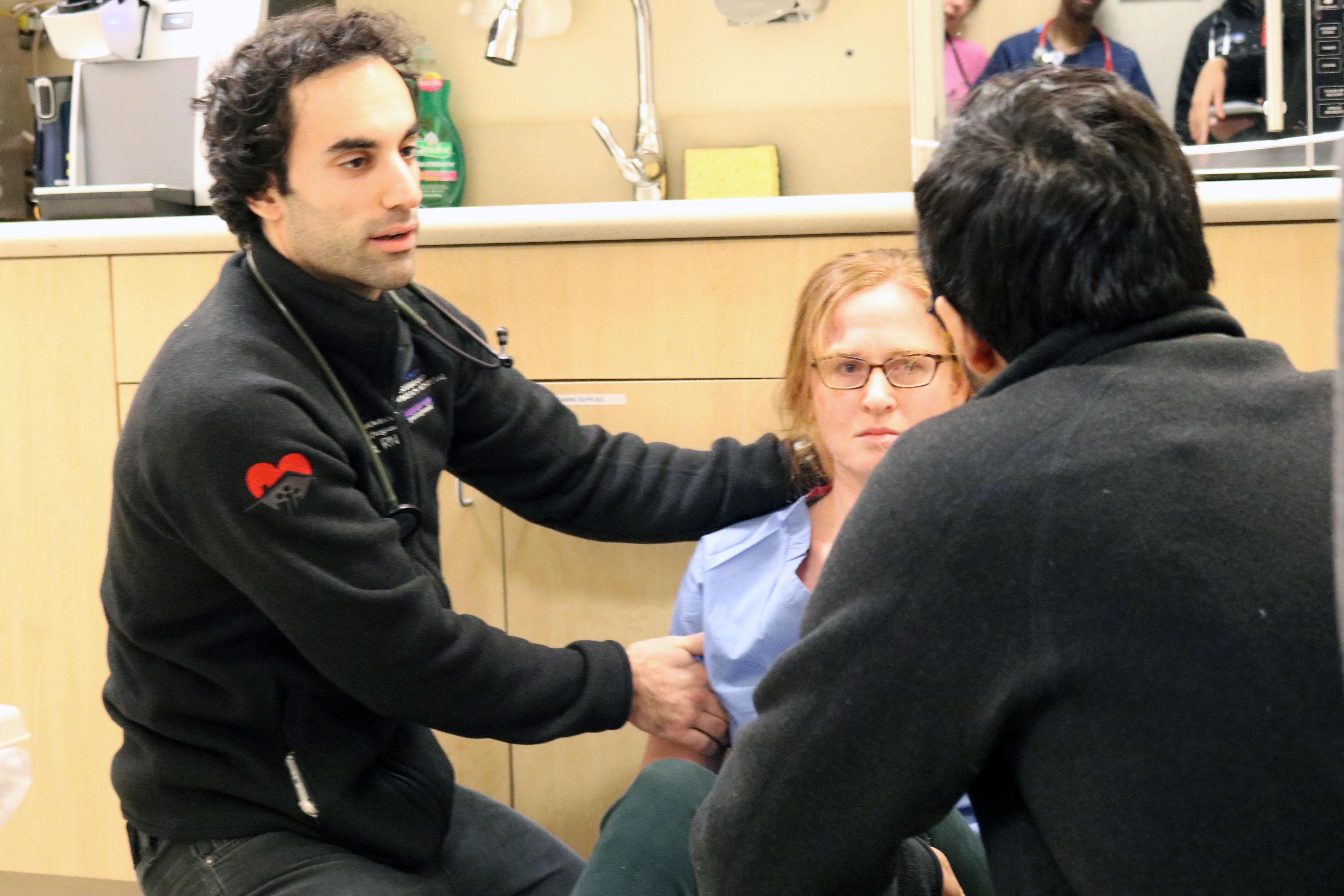From Falls to Fires, Staff Partner to Simulate Home-Hospital Scenarios

Nahall Rad (left) and Anish Mehta (right) simulate caring for a patient, played by Herrick “Cricket” Fisher (center), who has fallen in her kitchen.
While home-based hospital care yields considerable benefits for patients, it also poses unique challenges for care teams as they monitor and treat patients outside the controlled environment of a hospital.
Members of the Brigham’s Home Hospital team recently collaborated with experts at the Neil and Elise Wallace STRATUS Center for Medical Simulation to transform the center’s space in Neville House to mimic a home setting. They practiced responding to events the clinical team might encounter in a patient’s house or apartment—running the gamut from emergency to end-of-life scenarios.
The Home Hospital program provides hospital-level care to select acutely ill adults in the comfort of their home. Eligible patients, who must live within five miles of the Brigham’s main campus or BWFH, are enrolled via the Emergency Department upon seeking care for issues such as infections and exacerbations of heart failure, asthma and chronic obstructive pulmonary disease. If inpatient care is needed, the Home Hospital team will discuss the opportunity with the patient to receive care at home instead of through a conventional hospital admission.
The recent exercise with the Home Hospital team was a first for the simulation experts at STRATUS, who usually set up their facilities to look like traditional hospital settings, such as an operating room or patient room. For this training, STRATUS staff created a mock foyer, kitchen, bedroom and living room.
Seeing the Team Come Together
During the exercise, the nine-person Home Hospital clinical team went through six scenarios, including caring for a patient who has fallen in his or her kitchen; what to do when a dementia patient has forgotten to turn off the toaster, leading to a small fire; and speaking with a cancer patient about end-of-life and goals of care. With assistance from STRATUS, they acted out each scenario and reviewed the appropriate protocols and procedures for handling each situation.
“Our team was phenomenal,” said David Levine, MD, MPH, MA, a physician and researcher in the Division of General Internal Medicine and Primary Care who oversees the Home Hospital program. “To see our clinical team come together to enhance their home-hospital skills and learn from each other was beautiful. I am very proud of our team and look forward to organizing more simulated training experiences with STRATUS in the future.”
Home Hospital nurse Nahall Rad, BSN, RN, said taking part in these types of simulations is critical because it prepares the team for the challenges of delivering care outside the hospital.
“The dynamic nature of patient care in the field requires you to be as best prepared as possible for managing unforeseen and emergency scenarios,” Rad said. “The training we received at STRATUS was crucial in allowing our clinicians to be exposed to these types of experiences in a controlled environment to receive feedback on what was done well and what could have been done better. This allows us to have the highest level of patient care and improves our patients’ outcomes that much more.”
Also participating in the training was Gregory Goodman, MD, a Home Hospital attending physician. He appreciated the opportunity to work through the different cases with the team and learn about ways to improve patient care in the home setting.
“This was a powerful opportunity to work with our Home Hospital colleagues to improve our approach to care in a real-life way,” Goodman said. “It was great to see our team work together to collaborate to deliver exceptional and innovative care.”
Preparation Is Key
Planning and organizing such a course takes a lot of preparation behind the scenes—one year to be exact, Levine said. From writing the curriculum to ordering the furniture and equipment for the simulation, both teams wanted to ensure the course was as authentic as possible.
Michael Sampson, CHSOS, senior medical simulation specialist at STRATUS, enjoyed working with Levine and the entire Home Hospital team to create the course and operate the computerized simulation manikins during the training. He said seeing their passion for continued learning was inspiring.
“It is truly a team effort to put on simulation programs at STRATUS,” Sampson said. “It requires extensive planning and dedication from our staff and faculty members.”
Jamie Robertson, PhD, director of Education at STRATUS, also worked closely with the team to create the curriculum for the course. She said it was an exciting opportunity to think creatively about how to simulate the most realistic experience possible for Home Hospital providers.
Charles Pozner, MD, executive director of the STRATUS Center, said the course is another example of how STRATUS continues to contribute to the transformation of care delivered by Brigham Health providers. “This unique interprofessional program not only enables the Home Hospital staff to stay current with procedural care, but it also provides an excellent opportunity to strengthen the team-based care that is crucial in making this program such an overwhelming success,” Pozner said. “STRATUS takes pride in ‘pushing the envelope’ in health care education and research.”

Leave a Reply